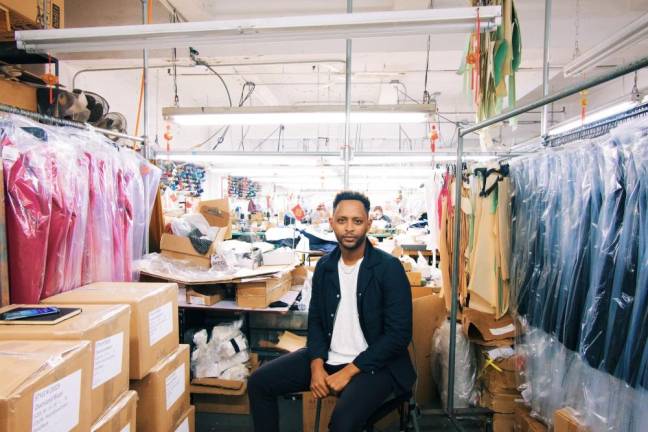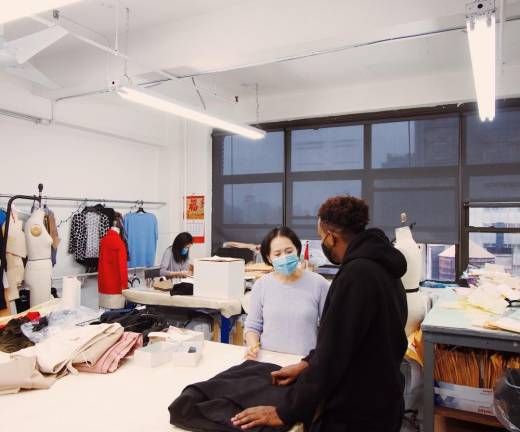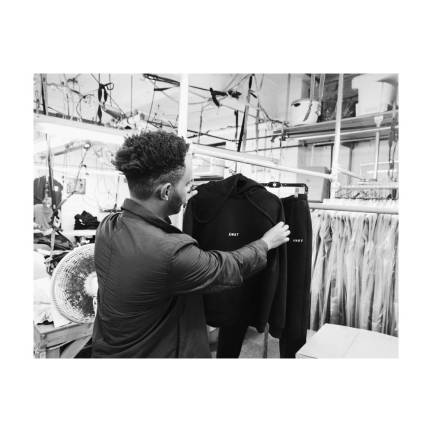Awet Woldegebriel was drawn to the grit of the New York City — to the struggle, the grind, and something that would push him harder and further. He was living in Atlanta in a corporate job at Coca-Cola and was missing something from his life. As refugees from Eritrea, Woldegebriel’s father brought him to America when he was eight years old. He was named “Awet” which means victory, because the month he was born, his country finally saw victory from war.
Twenty years later, at 28, Woldegebriel is taking his father’s memory and his love of New York and has created a line of loungewear, every part of which is made in New York City. The Garment District is one of many parts of New York that was affected by the pandemic.
“When COVID hit, I think we all kind of stepped back and looked at our life and looked at the stories we remembered. We thought about our family,” he said. “What I thought about was my dad, and how he didn’t have any skills, but he knew how to sew clothes together.”
Woldegebriel has a special connection to the people who work in the garment industry, because his father was a tailor.
“I’ve always had a very intimate relationship and view of people who are in the garment districts,” he said. “To be able to support men and women, just like my dad, who are so many times overlooked, but they’re the ones who are really running our city, it’s like a true pleasure.”
Betting on the People
Awet put in his entire life savings to start this line. Before that, he was saving to buy a house. “When else can I really invest in New York like this?” he asked. But he insists that he isn’t really betting on himself; he’s betting on the people in the Garment District. He works with Karen and Teddy Sedakas, a brother and sister duo who have been in the garment industry their entire lives. His whole team is a total of 40 people.
Woldegebriel’s name is in white letters on the $450 black hoodies, the $350 black sweatpants, and the $160 black hats. He was diligent about every part of the products being sourced locally. The hat is made by Peter Sur, who Woldegebriel calls “the last hatmaker in New York,” and who is based in Williamsburg.
“The sticker, the tag, the flag, the posters, the postcard, photographer that will take the picture of the model, every single part of the packaging, the string that we would use for packaging,” he said. “You can imagine it’s very hard to be like, ‘No, we can’t use that string if it’s not made here, that we use can’t use that stamp if it’s not me here.’”
Woldegebriel says he doesn’t have a “target demographic” for his clothing. “I think my demographic are people who understand, ‘Hey, it’s going to be expensive, but it’s worth it,’” he said. “I want it to serve as a uniform for people who believe that we should reinvest in New York.” He said that the materials the clothes are made of — locally sourced cotton, polyester, and a “silk sheen” to give it extra softness — makes it feel “delicious.”
“Downsizing and Downsizing”
Even though he was drawn to life in the city, Woldegebriel didn’t want to watch New York itself struggle. Due to outsourcing, he said, the Garment District has been struggling for a while. The AP reported that in 1987, the district occupied 4 million square feet of New York City, and by 2018 it was 700,000 square feet. In the same year, only 5,000 people were estimated to still work in the garment industry. In 2018, Manhattan Borough President Gale Brewer and NYC Council Speaker Corey Johnson worked with the NYC Economic Development Corporation to preserve the Garment District and incentivize property owners to utilize their space for apparel manufacturing.
“They’ve been downsizing and downsizing and downsizing and downsizing,” Woldegebriel said. “And if we don’t do something, if we don’t build brands that are really centered around their skills, or brands that are centered around building here and making here, what will happen is we’ll lose it.”
While the pandemic caused the city-wide shutdown from March to June this year, NY1 reported that because shipments from China were canceled due to the virus, New York garment workers received an influx of orders to close the gap for retailers. Shifting the manufacturing work away from outsourcing and back to New York is what Woldegebriel hopes to see.
“When we really outsource it out to another country, no matter what, you just don’t know what the supply chain looks like,” he said. “I think when we come back to producing in New York and producing locally, we know how people are treated.”
If the Garment District were to disappear, it would take thousands of jobs with it, and, Woldegebriel says, an entire “pocket” of New York City.
“So many have come here and said, ‘Oh, there is a place for me to work.’ The Garment District was a place that people saw an opportunity for themselves to create a business and to really thrive.”


